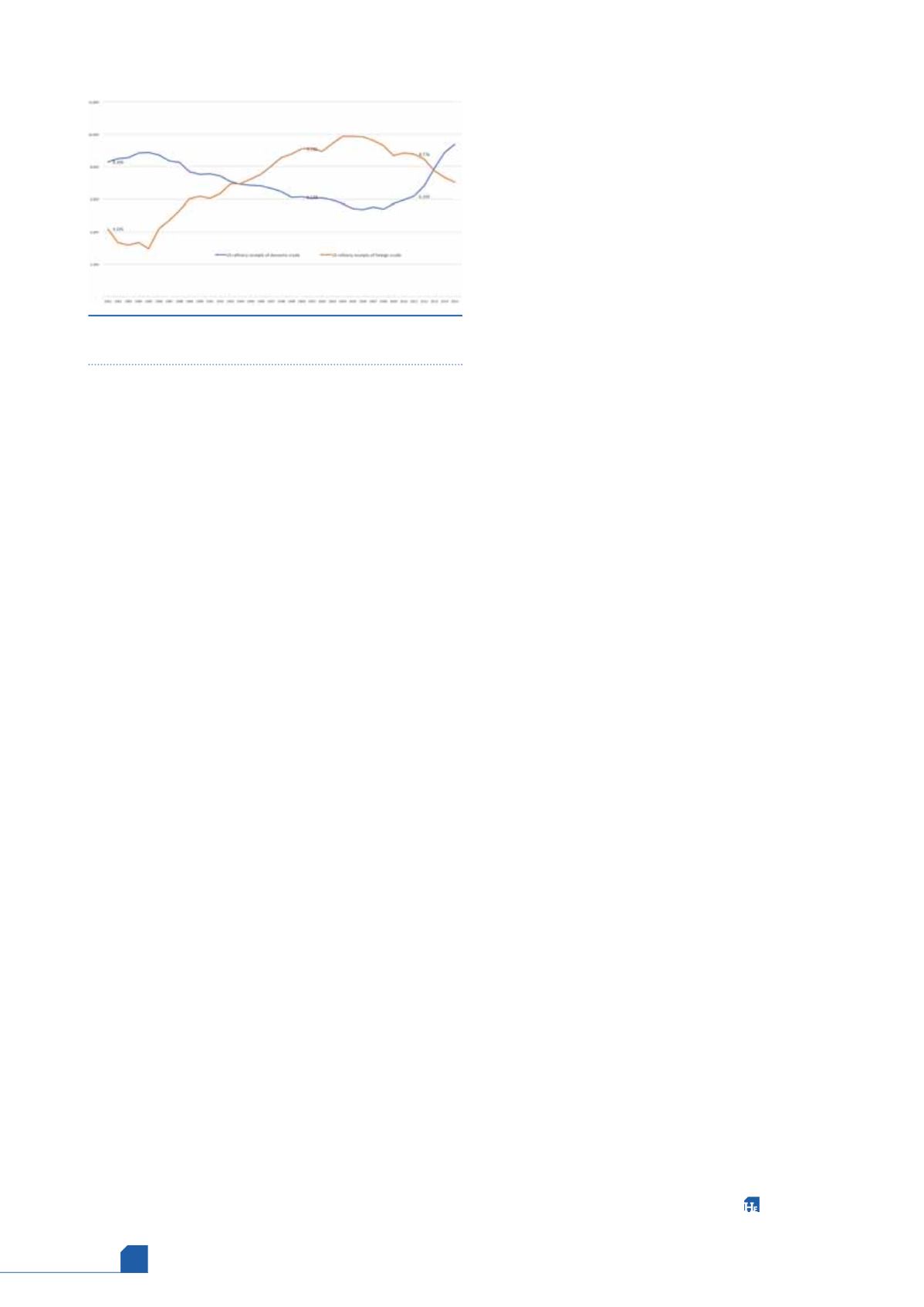
March
2017
HYDROCARBON
ENGINEERING
24
Pipeline age and safety record
Pipelines are considered the safest and least expensive mode
for delivering crude to refineries, though even they can leak or
rupture if damaged. The majority of US pipelines were built
prior to 1970. When installed and maintained properly, steel
pipelines can last for many decades, though welds and
connection points can eventually become compromised. In
2011, after serious incidents with natural gas pipelines, the
US DOT and its PHMSA issued a call to action to accelerate the
repair, rehabilitation, and replacement of the highest risk
pipelines. The highest risk factors were age and material, since
many of the oldest pipelines were built of cast and wrought
iron rather than steel. The biggest threats to these lines is earth
movement, usually caused by digging, seasonal frost heave, or
changes in groundwater levels. PHMSA now reports on pipeline
miles by decade installed.
As Figure 14 illustrates, the majority of refined product
pipelines were built between the 1940s and 1970s. A large
percentage of crude oil pipelines were also built during that
time period, but there was a significant increase in construction
of new crude pipelines during the decades 1990 – 1999,
2000 – 2009, and now completed or planned for 2010 – 2019.
Much of this investment came about because of the need to
transport crude from shale plays.
The increase in oil transported by pipeline, combined with
the risk factors of age and construction material, has
contributed to an increase in serious incidents over the past
decade. Serious incidents rose from 107 in 2006 to 179 in 2015.
On the positive side, however, the volume of barrels spilled has
declined. In 1996, PHMSA reported 160 188 bbls spilled. This
declined to 137 052 bbls spilled in 2005. Over the past decade,
there has been an increase in incidents, but oil spilled dropped
to 102 424 bbls in 2015. Figure 15 displays this relationship.
Public concern over pipeline safety has increased. PHMSA
recently received authority to issue industry wide emergency
orders. Previously, PHMSA was allowed to issue corrective
orders to only a single operator at a time, but Congress in
June 2016 granted the agency broader emergency powers. The
US midstream industry opposed this. Pipeline safety came back
into the limelight in September 2016 with the Colonial Pipeline
failure in a remote area of Shelby County, Alabama, which
spilled an estimated 6000 bbls of gasoline. The company
responded quickly, sequestering the spilled gasoline in mine
water retention ponds. It reported no threat to public health
or safety. Unfortunately, in the process of repairing the
pipeline, a work team ruptured the line, causing one
fatality and several injuries.
Conclusion: the next oil price cycle
and US crude supply
The US’ downstream oil sector has undergone, and is
undergoing, major changes. The strength in crude prices
helped give birth to the US shale boom, which greatly
expanded the supply of domestic crude and cut into
foreign crude import requirements. Many of the new
crudes were being produced in frontier areas that were
not connected to the established pipeline network
upon which US refineries relied. The refineries that had
access to the less expensive crude feedstocks achieved
high utilisation rates. The other refineries sought access
via less conventional transport modes, such as rail car,
tanker, barge, and truck. New pipeline connections
were built as well. Safety issues arose in areas where
crude had not been transported in such vast quantities
before. Concerns over public safety continue to exist,
and it remains to be seen whether infrastructure
investments and public policy changes will improve the
safety of oil transport.
The surge in US crude production contributed to
the global glut, however, which motivated Saudi Arabia
and other OPEC countries to launch a price war. The
lower prices eventually shut in some US production,
changing the crude diet and the modes of delivery. US
crude inputs to refining grew in 2016 while prices were
low. The question facing the industry is whether prices
will increase and remain high in 2017 because of the
OPEC and non-OPEC production cut pact. Or will high
prices tempt additional US domestic crude back into
production, and will this in turn cause prices to
weaken? Supply, demand and price continue to
interact.
Figure 16 illustrates how the cycle of US refinery
receipts of crude oil has shifted. In the 1980s, US
refiners received approximately twice as much
domestic crude as foreign crude. In 1981, domestic
crude runs averaged 8.306 million bpd, while foreign
crude runs averaged 4.195 million bpd. By the late 1980s,
US crude production entered into a period of decline
that was considered inescapable. Foreign crude receipts
rose steadily, reaching 9.887 million bpd in 2004.
Refinery receipts of domestic crude dropped to
5.721 million bpd in 2004. The shale boom changed this,
and it reversed the roles once again. In 2015, refineries
received 9.391 million bpd of domestic crude and
7.061 million bpd of foreign crude. In 2016, another
reversal seemed possible. US crude production was
declining, and foreign crude imports were rising. If the
OPEC-led price war had continued, it is possible that
US production would have entered into another period
of decline, and that foreign imports would have risen
again. Now, as 2017 commences, the global supply and
demand balance is in flux, and it remains to be seen
how the cycle of foreign crude vs domestic crude
continues in the US downstream sector.
Figure 16.
US refinery receipts of domestic vs foreign
crude; the shale boom causes the reversal.








